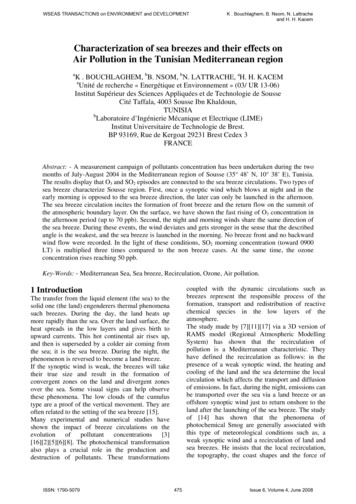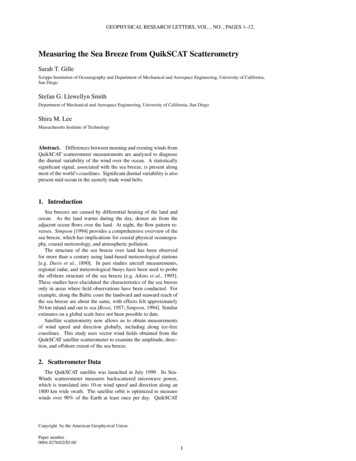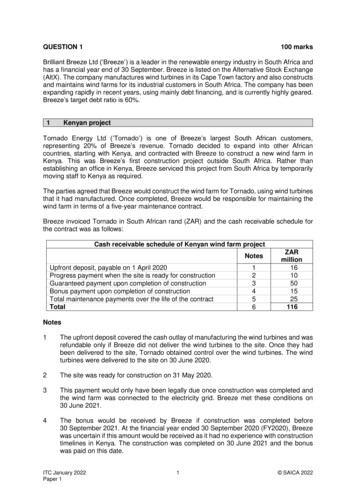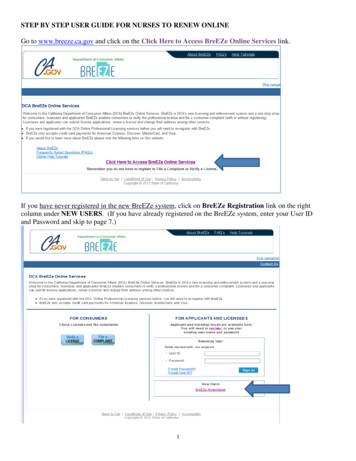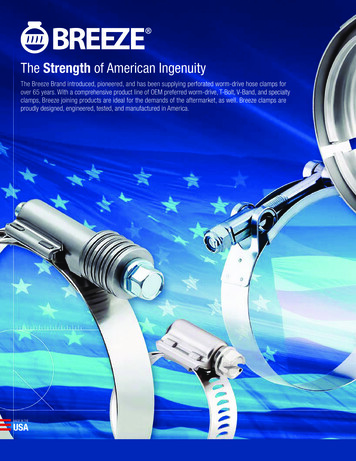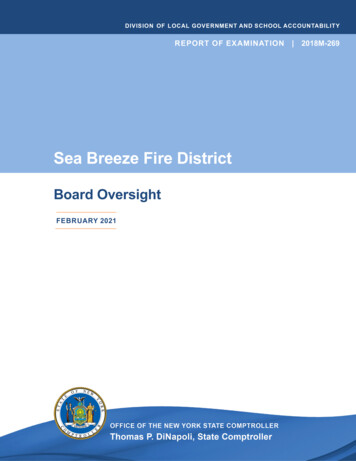
Transcription
DIVISION OF LOCAL GOVERNMENT AND SCHOOL ACCOUNTABILITYREPORT OF EXAMINATIONSea Breeze Fire DistrictBoard OversightFEBRUARY 2021 2018M-269
ContentsReport Highlights . . . . . . . . . . . . . . . . . . . . . . . . . . . . . 1Board Oversight . . . . . . . . . . . . . . . . . . . . . . . . . . . . . . 2What Is Effective Board Oversight? . . . . . . . . . . . . . . . . . . . 2The Board Did Not Adopt Adequate Policy Guidance . . . . . . . . . . 3The Board Needs to Improve Oversight of theTreasurer’s Duties. . . . . . . . . . . . . . . . . . . . . . . . . . . . 3The Board Did Not Comply With StatutoryTraining Requirements. . . . . . . . . . . . . . . . . . . . . . . . . . 4The Board Did Not Adequately Safeguard Vehiclesand Equipment. . . . . . . . . . . . . . . . . . . . . . . . . . . . . . 4What Are Adequate Records and Reports? . . . . . . . . . . . . . . . 5District Officials Did Not Maintain Adequate Records . . . . . . . . . . 6Adequate Reports Were Not Prepared or Filed . . . . . . . . . . . . . 7The Board and District Officials Did Not MonitorFinancial Condition. . . . . . . . . . . . . . . . . . . . . . . . . . . 8What Is an Effective Claims Audit Process?. . . . . . . . . . . . . . . 8The Board Did Not Perform an Adequate Claims Audit . . . . . . . . . 9What Do We Recommend? . . . . . . . . . . . . . . . . . . . . . . 12Appendix A – Response From District Officials . . . . . . . . . . . . 15Appendix B – Audit Methodology and Standards . . . . . . . . . . . 18Appendix C – Resources and Services. . . . . . . . . . . . . . . . . 19
Report HighlightsSea Breeze Fire DistrictAudit ObjectiveDetermine whether the Sea Breeze Fire District(District) Board provided adequate oversight of theDistrict’s financial operations.Key FindingsThe Board did not provide adequate oversight ofthe District’s financial operations. The Board didnot:llComply with mandatory training requirements.llActively manage District assets.llEnsure the Treasurer maintained basicaccounting records including adequate bankand debt obligation records.llComply with legal mandates to perform anannual audit, file financial reports or audit andapprove claims.llProhibit or address unsupported orquestionable disbursements.As a result, the Board could not effectively monitorthe District’s operations and financial condition.Key RecommendationsllllllAdopt or revise financial related policies andprovide oversight of operations.Prepare adequate accounting records andmonthly reports, and complete and file allrequired calculations, records and reports.Audit all claims before authorizing payment.District officials agreed with our recommendationsand indicated they have begun and will continue totake corrective action.BackgroundThe District is a district corporation of theState, distinct and separate from the Townof Irondequoit (Town) and Monroe County,in which it is located.The five-member elected Board of FireCommissioners (Board) is responsible forthe District’s overall financial managementand safeguarding its resources. Oneboard position was vacant in 2017 but itwas filled in 2018.The Board appoints a Treasurer to actas the District’s chief fiscal officer. TheTreasurer is responsible for the receiptand custody of District funds, disbursingand accounting for those funds andpreparing monthly and annual financialreports. The current Treasurer started inMarch 2017.The District provides equipmentand resources for use by the SeaBreeze Volunteer Fire Association Inc.(Association) to provide fire protectionservices within the District, under thedirection of the Fire Chief (Chief).Appropriation Quick Facts2016 120,7932017 128,8892018 130,178Audit PeriodJanuary 1, 2016 – February 22, 2018Of f ic e of t he New York State Comptroller1
Board OversightWhat Is Effective Board Oversight?A board is responsible for overseeing a fire district’s fiscal activities andsafeguarding its resources. An important aspect of this responsibility is to providea process to routinely monitor and review the work performed by those whohandle money as part of their district duties. Oversight becomes particularlyimportant in operations that do not have adequate segregation of duties. Ifone person, such as the treasurer, performs nearly all financial duties (e.g.,receives and disburses cash, maintains the accounting records and performsreconciliations), it may weaken control over the district’s financial operations. Itis essential that the board establish policies and procedures that ensure dutiesare sufficiently segregated; transactions are authorized and properly recorded;financial reports are accurate, reliable and filed in a timely manner; and the districtcomplies with applicable laws, rules and regulations. In addition, the board shouldadopt policies over information technology (IT) to safeguard data.New York State (NYS) General Municipal Law (GML) requires a board to adopt acode of ethics1 and investment2 and procurement policies3.A board’s oversight responsibility also includes legal requirements to audit allclaims before approving them for payment4 and to perform or contract for anannual audit of the treasurer’s books and records. As part of this audit, thetreasurer is required to produce all books, records, receipts, orders, vouchers andcanceled checks or check images.5 The board should ensure that the completionand results of the audit are included in its meeting minutes and documentation isfiled detailing how the audit was performed and the records reviewed.One way board members can become aware of their responsibilities related tostatutory provisions and sound management practices is to participate in themandatory training as prescribed by the Office of the State Comptroller (OSC).New York State Town Law (Town Law) and related OSC regulations6 require allfire district commissioners to complete an OSC-approved training course, within270 days of taking office, which covers legal, fiduciary, financial, procurement andethical responsibilities, and to retain documentation of successful completion forthe duration of their term(s). OSC provides additional training and publications tohelp boards provide effective oversight.1 General Municipal Law (GML) Section 8062 GML Section 393 GML Section 104-b4 Town Law Section 1765 Town Law Section 1776 Town Law Section 176-e and NYS Regulations nt/publications/pdf/trregs.pdf2Of f ic e of t he New York State Comptroller
Vehicles and equipment represent a significant investment of district resources.The board should actively manage district assets through established policiesor procedures to ensure that these assets are protected from loss throughaccidents or theft. Inventory records that are accurate, complete and monitoredregularly are an important control to ensure adequate insurance coverage andguard against theft. When assets are not closely monitored and included in upto-date inventory records, they are more susceptible to loss or theft. To protectthe district’s financial investment in these assets, it is essential that the districtmaintain adequate insurance coverage.The Board Did Not Adopt Adequate Policy GuidanceThe Board adopted a code of ethics and procurement policy but the procurementpolicy inappropriately exempts District officials from soliciting competition forprofessional services. The Board adopted a credit and debit card policy7 thatrequires the Board to pre-approve transactions for more than 500, but does notspecify how approval needs to be documented. As a result, we found five debitcard transactions for more than 500, totaling 4,850, with no documentation ofpre-approval.Additionally, the Board has not adopted an investment policy or otherfinancial policies to establish duties and requirements over key areas such asdisbursements, claims processing, required financial records and reports andbudgeting. As a result, District personnel lacked guidance to adequately performtheir financial duties. The Board has also not adopted any policies over IT,including breach notification,8 acceptable use and IT security awareness training.Without formal policies and training that explicitly convey appropriate use andpractices to safeguard data, officials cannot ensure that users are aware of theirresponsibilities or hold users accountable for inappropriate activity.The Board Needs to Improve Oversight of the Treasurer’s DutiesThe Board did not segregate the Treasurer’s duties or establish mitigatingcontrols. The Treasurer performed all financial duties with little or no oversight,including:llReceiving and disbursing District funds,llSigning District checks,llMaintaining financial records andllReconciling bank accounts.7 Refer to claims processing section for further details on risks of debit card use.8 NYS Technology Law requires local governments to establish an information breach notification policy. While firedistricts may not be subject to this law, it is still in the District’s best interest to adopt and implement such a policy.Of f ic e of t he New York State Comptroller3
The Board did not appoint someone to review the Treasurer’s bankreconciliations, bank statements and canceled check images, which would haveenabled the Board to provide oversight of the Treasurer’s work and also monitorthe District’s finances.The lack of oversight included the process for auditing the Treasurer’s records.The Board Chairman (Chairman) told us that there is no formal processin place for annually auditing the Treasurer’s records, but that he reviewscertain documentation himself. However, his review, and the scope of it, is notdocumented and the Board minutes do not contain any discussion regardingan audit or results. Without conducting or contracting for an annual audit, theBoard’s ability to properly monitor financial operations is diminished and errors,irregularities or misappropriation may go unnoticed.9The Board Did Not Comply With Statutory Training RequirementsAlthough District officials told us that the Commissioners completed themandatory training, they could not provide any documentation to support that therequired training was completed. Therefore, it is likely that the Board membersdid not complete their mandated training, which could explain why certain keylegal requirements and other responsibilities were not met. The training wouldhave informed the Board of vital legal requirements that they did not complywith, such as the statutory spending limit and filing of annual reports and tax capcalculations.Without proper training, the Board cannot assure residents it possesses the basicknowledge to provide effective management of District financial and non-financialactivities.The Board Did Not Adequately Safeguard Vehicles and EquipmentDuring our audit period, District officials’ control of vehicles and equipment waslimited. An asset list or inventory of its vehicles, apparatus or other equipment wasnot maintained. At the end of our audit fieldwork, in February 2018, the Chairmanprepared and provided an asset list of the District’s vehicles and major equipment.While District officials believed they had active insurance for loss and liability,they were unable to provide any insurance declarations or other documentationto support insurance coverage, including any premium bills or proof of payment.Without proof of insurance, the District could sustain substantial loss due tovehicle damage or injury to others.9 OSC has a publication available on our website entitled Fiscal Oversight Responsibilities of the GoverningBoard tions/pdf/fiscal oversight.pdf which containschecklists to assist the Board in providing and documenting an effective audit of the Treasurer’s records.4Of f ic e of t he New York State Comptroller
As further illustration of the lack of District control and awareness of these assets,Board members were unaware of details regarding an accident involving, andsubsequent repairs to, the Chief’s vehicle.During our concurrent audit of the Association, we found a 6,431 insurance claimcheck issued to the District on November 1, 2016, that was deposited into theChief’s Association bank account. The Chief told us that the insurance check wasfor repairs of accident damage to his chief’s vehicle, and that he was instructed todeposit the check into his account by the Chairman and another Board member.The Chairman told us that he did not recall an accident, or insurance claim, andwas not aware that this check was issued to the District or deposited into theChief’s account. He further stated that if he or another Board member were awareof the check, they would have directed that it be deposited into a District bankaccount.On November 16, 2016, a 6,000 cashier’s check was issued against the Chief’sAssociation account to an individual who owns an auto repair shop. The Chieftold us that the cashier’s check was issued to pay the cost of repairs to the chief’svehicle, but he provided no supporting invoice or documentation to supportthe amount, the extent of the repairs or the vehicle the repairs were made to.Furthermore, he provided no explanation or documentation for the final dispositionof the remaining 431.The Board’s failure to actively manage District assets exposes the District to therisk of financial loss. It also enabled the Chief to damage and repair a vehicle,and request and spend a District insurance recovery, all without the Board’sknowledge. This raises significant concerns that other incidents or activities mayhave occurred, unbeknownst to the Board.What Are Adequate Records and Reports?Fire district officials must maintain all policies, records and supportingdocumentation for all financial decisions and transactions in an organized mannerto readily provide information as needed by board members, taxpayers andother agencies or interested parties, and to comply with State record retentionrequirements.The treasurer must maintain complete and accurate records to properly accountfor all district financial activities in a timely manner and to provide the boardwith monthly financial reports that include the essential information it needs toeffectively manage and safeguard district resources. Reconciling bank accountbalances with the accounting records monthly is an essential control activity thatallows fire district officials to determine whether all cash receipt and disbursementtransactions were captured and correctly recorded in a timely manner.Of f ic e of t he New York State Comptroller5
Adequate monthly reports should include revenue and expenditure budgetto-actual analyses to help the board monitor financial performance againstbudgetary estimates and address potential shortfalls as early as possible.The treasurer is required10 to prepare and submit an annual financial report,known as the Annual Update Document (AUD), to OSC within 60 days of the endof the fiscal year.11 The district’s spending limit, established by Town Law,12 is themaximum amount the district may expend without having to obtain voter approval,and must be calculated and adhered to during the budget process. Additionally,before adopting a budget for the coming year, district officials must submit the taxlevy limit calculation to OSC.13A board may retain a reasonable amount of fund balance necessary to ensurethe orderly operation of the fire district, address unforeseen circumstances andprovide cash flow to compensate for timing differences between when revenuesare received and expenditures are made.14 Retaining more fund balance thanreasonably necessary can result in unnecessarily high real property tax levies.District Officials Did Not Maintain Adequate RecordsDistrict officials did not maintain basic records in an organized manner andrequired repeated requests to provide records, such as policies and Boardminutes. The District’s accounting records consisted of a check register thatprovided a running cash balance. Other records such as balance sheets, revenueand appropriation subsidiary records needed to provide timely monitoring andreporting of finances were not maintained.Beyond accounting records, other financial records were not available. Forexample, the Treasurer was unable to provide us with canceled check imagesbecause the District does not receive images on the bank statements or printthem from the online banking system to meet record retention requirements.15District officials were also unable to provide us with an agreement with the bankthat set forth the services to be provided, including how canceled check imageswould be made available. The lack of canceled check images for Board reviewseverely limits its ability to provide effective oversight.10 By GML Section 30 and Town Law Section 181 (6)11 The AUD provides a complete summary of district financial activities and its year-end financial condition.12 Town Law Section 176 (18)13 GML Section 3-c restricts the amount of real property taxes that can be raised.14 Town Law Section 181 (2-b)15 The NYS legal minimum retention period for canceled checks and bank statements is six years.6Of f ic e of t he New York State Comptroller
In addition, the Treasurer was not familiar with and was unable to providedocumentation or information for the District’s outstanding debt. The Chief, at therequest of the Chairman, acquired loan documentation from the lending institutionbecause District officials could not provide it to us.The current Treasurer did not prepare bank reconciliations. She prepared andprovided to the Board a monthly spreadsheet that listed the disbursements forthe month, with their associated account code, and bank account balances,without dates. We reviewed bank statements16 and noted that she did not recordmonth-end bank balances on her monthly report, but only the balance sheretrieved from the online banking system as of the date of the Board meeting atwhich she presented the report. Listing book and bank balances as of differentdates did not allow for reconciliation or identify any discrepancies or differencesdue to outstanding checks, deposits, unrecorded transactions or errors. Inaddition, while District officials told us that bank statements were presented tothe Board monthly, neither the Board minutes nor the available bank statementsincluded any indication that the Board received or reviewed bank statements orreconciliations.The Board’s failure to require the Treasurer to prepare adequate detailedaccounting records, bank reconciliations and monthly reports, and retain checkimages and documentation on loans and bank agreements, severely limited itsability to monitor the District’s operations and financial condition.Adequate Reports Were Not Prepared or FiledThe lack of records complicates the filing of necessary reports. The recordinadequacies discussed previously contributed to the Treasurer not:llPreparing or filing an AUD for 2013 through 2017. District officials told usthey were unaware of the annual reporting requirement.17 However, OSCsent filing instructions, followed by multiple delinquent AUD letters to theTreasurer every year at the District’s mailing address. Without filing annualfinancial reports, District officials are violating GML and Town Law provisionsand the Board and District residents have no information with which toassess or monitor the District’s financial status.llCalculating or providing the District’s statutory spending limit for 2016,2017 or 2018 during the budgetary process. The Board adopted budgetsexceeding the statutory spending limit in 2016 (by 8,280), 2017 (by 15,462) and 2018 (by 16,326). Further, actual expenditures exceeded the16 For the seven months that she had been Treasurer – March through September 201717 Prior to 2013, the District was governed by the Town Board and the Town reported the District’s financialactivity on its AUD. The District separated from the Town following a March 14, 2012 Town Board resolution tocreate a new Sea Breeze Fire District.Of f ic e of t he New York State Comptroller7
statutory spending limits by 17,280 (14 percent more than the limit) in 2016and 13,884 (13 percent) in 2017 without voter approval to exceed the limit.Without calculating and filing the District’s statutory spending limit, Districtofficials have not provided residents a transparent view of District finances orassurance that the District has complied with legal requirements.llCalculating or filing the District’s tax levy limit calculation for 2017 or 2018 asrequired.llPreparing monthly reports comparing budgeted revenues and expenditureswith actual results.As a result, the Board did not have information necessary to make financialdecisions including ensuring budgets were within statutory limits. The lack ofreports deprived taxpayers of the transparency necessary to evaluate the Board’sdecisions, the assurance that budgets conformed to statute and the right to voteon the additional expenditures.The Board and District Officials Did Not Monitor Financial ConditionDue to the lack of adequate and complete accounting records and monthly andannual financial reports, the Board had no readily available information with whichto assess and appropriately monitor financial results against its adopted budgetsand the District’s overall financial condition. District officials did not know howmuch fund balance the District had because the Treasurer did not sufficientlyrecord financial activity to accurately calculate and report fund balance. Therefore,we reviewed the District’s bank balances to estimate fund balance as a way toevaluate the District’s financial condition. We found that the District’s total bankbalance was approximately 72,016 at the end of 2016, 62 percent of 2016expenditures. The total bank balance increased to 100,497 at the end of 2017,or 92 percent of 2017 expenditures.Without documented Board analysis and justification for retaining such highbalances, the District’s fund balance seems excessive and should be used toreduce real property tax levies in coming years or set up reserves to meet thelong term needs of the District.What Is an Effective Claims Audit Process?Town Law18 requires the board to audit all claims against the district prior topayment and, by resolution, order the Treasurer to pay the audited claims. Aneffective claims auditing process ensures that every claim against the district issubjected to a thorough and deliberate review to verify that each claim contains18 Town Law Section 176 (4-a)8Of f ic e of t he New York State Comptroller
adequate supporting documentation to determine whether it complies withstatutory requirements and district policies, and the amounts claimed representactual and necessary district expenditures.Debit cards pose significant risks because they allow payment to be directlywithdrawn from the bank account at the time of purchase without prior approval,and unauthorized use may not be readily detected. Board policy requires receiptsfor all debit card purchases, detailing the name of the individual who incurred thepayment, the reason for and amount of the payment, attached to a voucher andsubmitted to the Board for approval.The Board Did Not Perform an Adequate Claims AuditThe Board did not adopt a claims audit policy and did not perform an adequateclaims audit. Board members told us that one Board member reviews each claimbefore signing the ‘checked by’ voucher line and then passes it on to the otherBoard members who also sign the voucher. Additionally, the claims audit processis circumvented by the use of a debit card which results in direct payments priorto Board approval. Further, the Board minutes state that bills have been approvedfor the month, but do not include any description or details regarding the totalnumber or amount of vouchers approved for payment.We reviewed all 317 disbursements totaling 203,561 made from January 1, 2016through September 30, 2017. We found errors that indicated flaws in the process.These included:ll33 disbursements totaling 47,816 (23 percent) that did not have adequatesupporting documentation.ll98 disbursements (31 percent) totaling 66,785 that were not eligible for prepayment and were paid prior to Board approval based on the signature dateson the vouchers. This includes 25 purchases totaling 11,543 made with adebit card.ll56 disbursements totaling 23,753 that did not have documentation ofverbal quotes and 10 disbursements totaling 26,014 that did not havedocumentation of written quotes required to be obtained by the District’sprocurement policy. The Chairman initially told us that they obtain quotes, butdo not retain documentation. However, he subsequently informed us that theTreasurer retains the quotes and should have them with the claims. Lackingdocumented quotes, the Board cannot assure taxpayers that the Districtobtained goods and services at the best available prices or quality.Of f ic e of t he New York State Comptroller9
Within these disbursements, we specifically noted two payments (January 2016and February 2017) totaling 3,000 to the Chief19 for the annual installationdinners, one 550 payment (February 2016) to the Chief with the description oftraining reimbursement, one 2,000 payment (May 2016) to the Association fordrill team expenses and one 2,719 payment (May 2017) to a Commissionerwith the description “remainder drill team budget.” We also noted two payments(February 2016 and March 2017) totaling 31,000 to the Association for rent.However, these payments were made without having a formal lease. The lack ofsupporting invoices, receipts, leases or other documentation increases the riskthat the District’s funds were not used for legitimate District purposes.On our follow-up inquiries regarding the lack of documentation for thesedisbursements, the Chairman requested documentation from the Chief andCommissioner to support these payments because the Board did not have thedocumentation when payment was made and did not require the individuals tolater submit documentation of how the funds were used. We met with Districtofficials at the end of our audit field work, on February 22, 2018, and receivedcertain additional documents:llThe Chief provided us with two invoices totaling 2,995 for catering for the2016 and 2017 installation dinners. He told us that he had just obtainedthese invoices from the vendor, to support the two 1,500 payments hereceived. We had concerns about the authenticity of these invoices, whichappeared to have been created from a template as various sections usedstock language and were not adjusted for an actual invoice. For example,they did not prominently include the vendor’s name or logo, and included anincomplete email address, a sample customer ID of “ABC12345” and “[Yourcompany slogan]” at the bottom. Furthermore, in previous discussions, theChief had told us that the funds he received from the District were used tocover all of the various installation dinner costs including the bar tab andancillary costs, in addition to the caterer. He also stated, on one occasion,that the installation dinner catering cost should have been around 900,and that this vendor catered the 2017 dinner because they had problemswith the previous vendor, implying that this vendor did not provide anycatering services for the 2016 installation dinner. Additionally, there wereno lists of attendees to support the number of meals paid for as indicatedon the invoices provided. Finally, we made numerous attempts to verify theinvoices, however, the vendor is no longer in business and the owner saidshe did not have original invoices to provide.19 Both checks were written to the same individual, who was Chief for 2016 and technically held the AssistantChief title for 2017, but functioned in primarily the same (financial) capacities both years.10Of f ic e of t he New York State Comptroller
llThe Chief provided an expense reimbursement form – which he told ushe had just created - to support the 550 ‘training reimbursement’ with nosupporting documentation from the training institution. Although the Boardminutes approved two unnamed Commissioners to attend training for 550,no documentation was provided to indicate who, if anyone, registered for,attended or paid for the training. After our audit fieldwork, we obtained aroster of attendees directly from the training institution. We did not findany Commissioners’ names but found that the Chief attended. During asubsequent discussion, the Chief told us that the Assistant Chief attendedwith him. However, that individual’s name was not on the roster. Wereceived no documentation to support the amount paid, the Assistant Chief’sattendance, or why the attendees were not Commissioners as approved inthe Board minutes.llThe Chief provided various invoices recently obtained from vendors thathe said were paid from the 2,000 check to the Association for the drillteam in 2016. However, most of the support provided did not correspondto disbursements made from the Association Chief’s account to which thatcheck was deposited.20llThe Chairman provided bank statements, invoices and receipts to supportthe 2,719 payment to the Commissioner for drill team expenses on May4, 2017. The bank statements were for a personal account in the name ofthe Commissioner to whom the check was written, with a “DRILL TEAM”designation, and were sent to the Commissioner’s home address. However,we noted that the 2,719 District check was not deposited into this bankaccount. Deposits to the “DRILL TEAM” account totaled 2,276 and includedtwo transfers from a different personal bank account ( 2,000 on May 10,2017 and 111 on June 16, 2017) and a 165 ATM cash depos
and resources for use by the Sea Breeze Volunteer Fire Association Inc. (Association) to provide fire protection services within the District, under the direction of the Fire Chief (Chief). Audit Period January 1, 2016 - February 22, 2018 Sea Breeze Fire District Appropriation Quick Facts 2016 120,793 2017 128,889 2018 130,178
